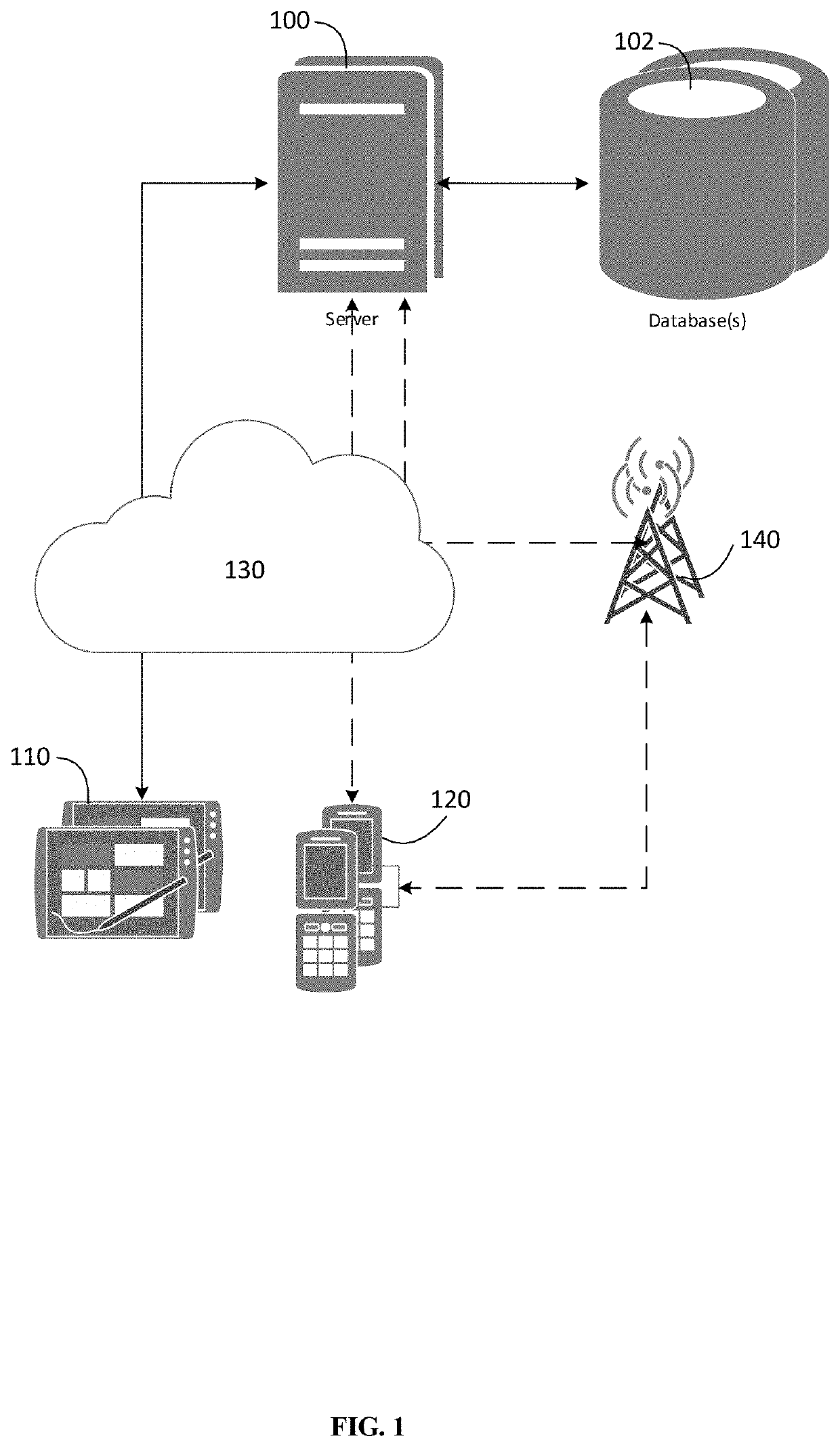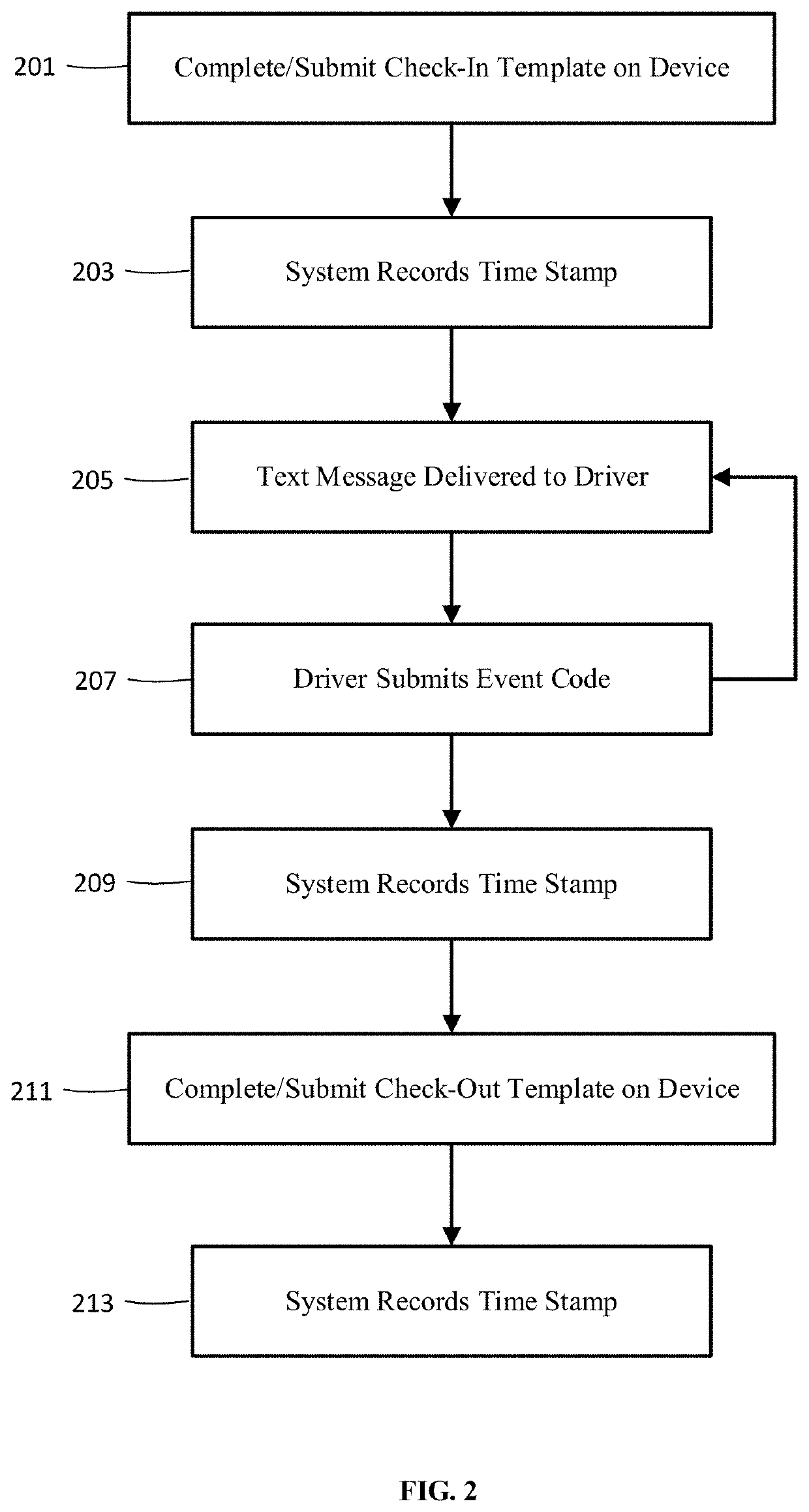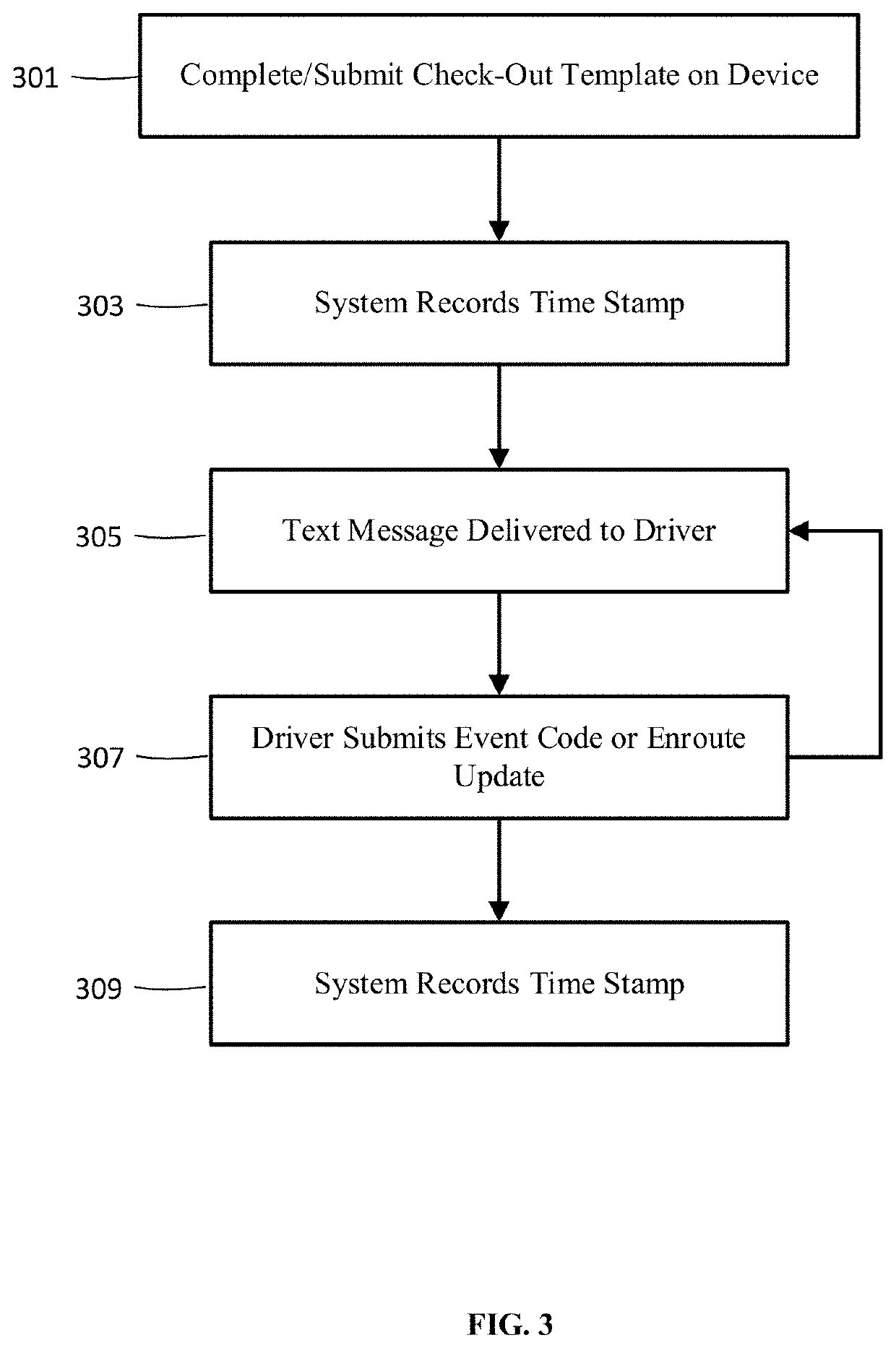Unfortunately, real-time
visibility for the shipper to shipment events, or to the driver's remaining hours of service (“HOS”) before his next break (required to accurately estimate the
time of arrival), or to events at the receiving location, is not provided by currently available solutions on every shipment.
Furthermore, these solutions do not provide
visibility to shipments where the transport was arranged by a party other than the shipper, such as by a vendor supplying goods to the shipper (“vendor delivered order”) or by a customer picking up their order at the shipper (“customer pick-up”).
Tracking solutions that rely on
cell-
tower triangulation are (or were) popular with drivers but are not accurate enough to precisely
timestamp events and do not capture events.
These solutions have been (or are at-risk of being) discontinued by the cellular service providers because of privacy concerns.
Unfortunately, driver adoption is low due to “app fatigue”; small carriers and owner-operators contract with many brokers and are simply overwhelmed by the complexity of having to use many
mobile apps.
Some leading “app-platform” brokers struggle to achieve over 50% adoption.
Even if the driver does use the broker's
mobile app, the
event data provided by the app can be inaccurate.
But this approach also has limitations.
And, ELD data can be associated with the wrong shipment; it is difficult to know when to start and stop tracking (by calling the ELD service for
tracking data), resulting in “overhang” where the calls for
tracking data are started too early (and the assets are still assigned to the prior shipment) or are stopped too late (and the assets are now re-assigned to the next shipment).
Carriers are concerned that others (who seek to monetize the data) might mis-use overhang “too early” data by assuming that the asset is “empty and available,” when, in fact, it has not yet completed its prior delivery.
Drivers are, as before, concerned about “too late” overhang compromising their privacy.
In addition, last minute
tractor assignment changes can result in the ELD data being associated with the wrong shipment.
Hand-offs or relays (from one driver /
tractor to another) can also result in incorrect tracking; the first driver is now off the shipment (but still being tracked) and the second driver has not been properly associated with the shipment.
Finally, some small carriers and many owner-operators use ELD's that are not connected to a cloud portal; data on such systems cannot be remotely accessed.
As a result of these limitations, shippers do not enjoy accurate real-time visibility to location and events for all their shipments.
If that time is exceeded, additional fees are incurred.
In many cases, carriers do not have reliable arrival and departure event
timestamp information for the above reasons.
Lacking this data, they often submit incorrect invoices.
Invoices can also be incorrect due to mistakes or misrepresentation of detention and demurrage times. In addition, some carriers are also unable to apply shipper-specific rules (e.g., such as the detention
clock starts on the later of the
appointment time or actual arrival timestamp, but if actual arrival is after the grace period then the carrier is not eligible for detention) and thereby accurately calculate the assessorial fee.
In some cases, a majority of a company's carrier detention invoices may be invalid resulting in potentially millions of dollars of overpayments.
Timestamps that are handwritten on shipping documents and filed away are not easily available for
invoice validation.
Similarly, timestamps captured electronically (e.g., in the warehouse or
yard management system) can be inaccurate, difficult to retrieve and / or for the trailer only as these systems are typically trailer-centric (
tractor-only gate events are often not even recorded).
It is, therefore, difficult for shippers to validate the detention and demurrage assessorial charges invoiced by the carriers.
Frustrated by these limitations, shippers often resign themselves to simply auto-paying invoices if they are below a threshold value or “rubber-
stamping” assessorial invoices as the approving managers do not have the time nor easy access to the appropriate data to research and validate the invoices.
Finally, shippers do not have visibility to the delivery of goods if the customer arranges the transport (customer pick-up).
Arguments often ensue when the customer inventory planner discovers that inventory is short because the CPU delivery did not arrive on time.
Shippers that hire third-party carriers to transport their goods often do not have easily accessible data, or no data at all, on the cycle times (and component events) to receive and unload, or to load and dispatch, shipments.
Without such data, the shipper is unable to identify the process bottlenecks and implement effective corrective actions.
This labor-intensive process publishes results two weeks after the event.
For example, they might not be able to timestamp when an incoming driver drops a trailer (full for unloading or empty for loading) in the
yard.
Furthermore, these systems provide no visibility to off-site events, such as remaining HOS for the driver, en-
route location updates, and check-ins / check-outs at customer destinations.
Even if YMS / WMS systems were capable of monitoring all on-site and off-site events and the data were visible to remote users (such as the carrier and
receiver), these systems are expensive and require a lengthy specification, installation and configuration process and are, therefore, not justified for many locations, especially small and mid-size warehouses.
Unfortunately, EDI 214 messages often
lag the actual delivery.
This is especially problematic for brokered shipments.
EDI protocol is also dated and burdensome, and typically requires custom
programming for every shipper to carrier
pairing.
Unfortunately, many owner-operators have invested in ELD's for HOS compliance that are not connected to anything, as discussed above.
Unfortunately, this visibility is difficult, if not impossible, to effect with current solutions because 1) the tractor cannot be associated with the container in advance as the pick-up sequence often is not or cannot be controlled and 2) the
lag-time of making the association in real-time is often longer than the
transit time.
As a result, the
receiver only gains visibility to the container (and its contents) on delivery.
In addition, the current solutions do not provide the
receiver with the opportunity to request that the dray driver prioritize critical containers.
Unfortunately, small-carriers and owner-operators do not typically have this capability.
Not only are downloads expensive, but out-bound shipments might be short-shipped while waiting for the product to be unloaded and / or released from
quarantine.
These same issues exist for other devices that measure the condition of the shipment, such as
humidity, shock, or seal tamper devices.
There is also a desire to track individual trailers and shipments, though existing trailer telematic devices have not be widely adopted due to the expense and technical limitations.
Devices that rely on an external power source (from the tractor or from solar panels) are expensive to purchase and to install.
Battery powered devices are available but, unfortunately, the battery life is typically not sufficient to provide the frequency of tracking (at least hourly) required for meaningful tracking of a shipment.
Such devices must, then, be recharged or replaced, with the associated costs.
Despite attempts to capture information during the shipping process, problems with the accuracy and availability of data persist and remain a significant unsolved problem in the field.
 Login to View More
Login to View More  Login to View More
Login to View More 


